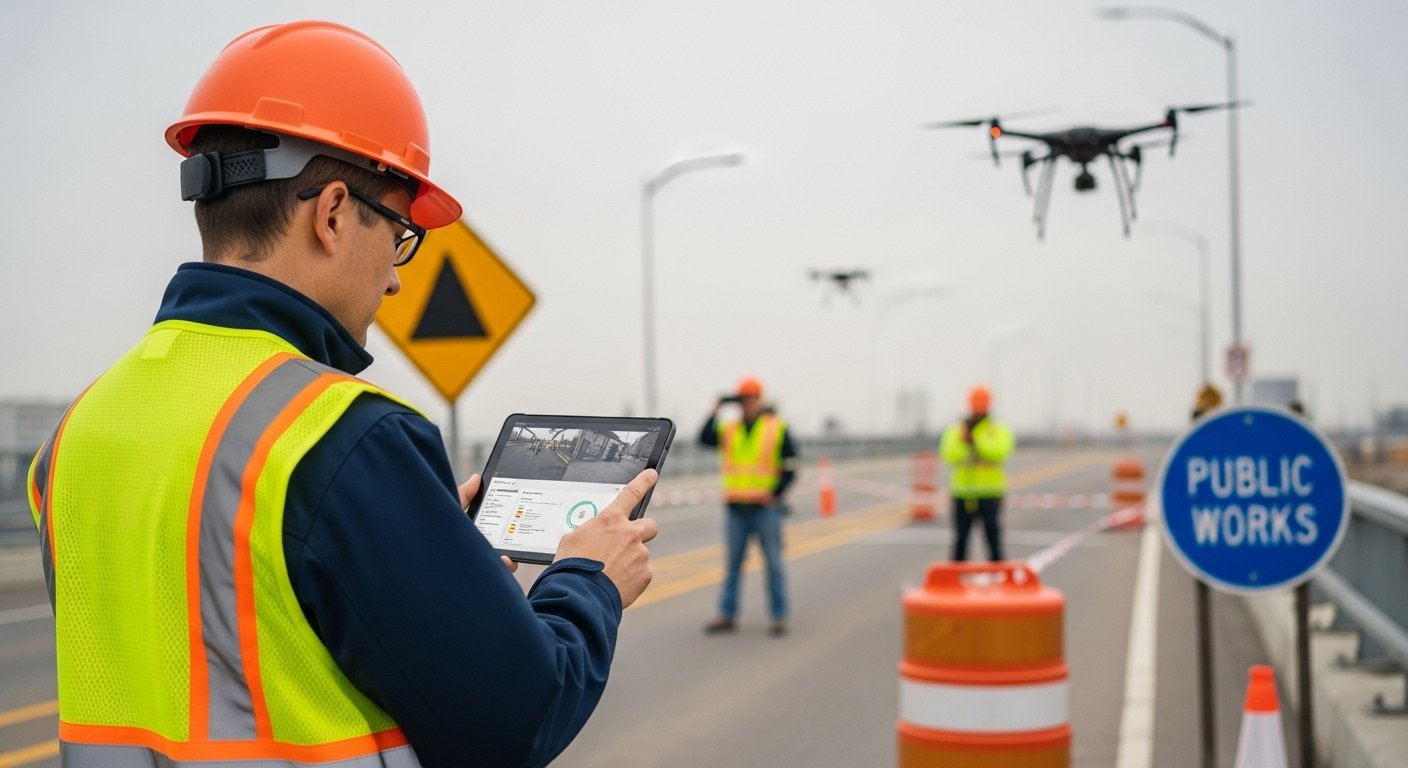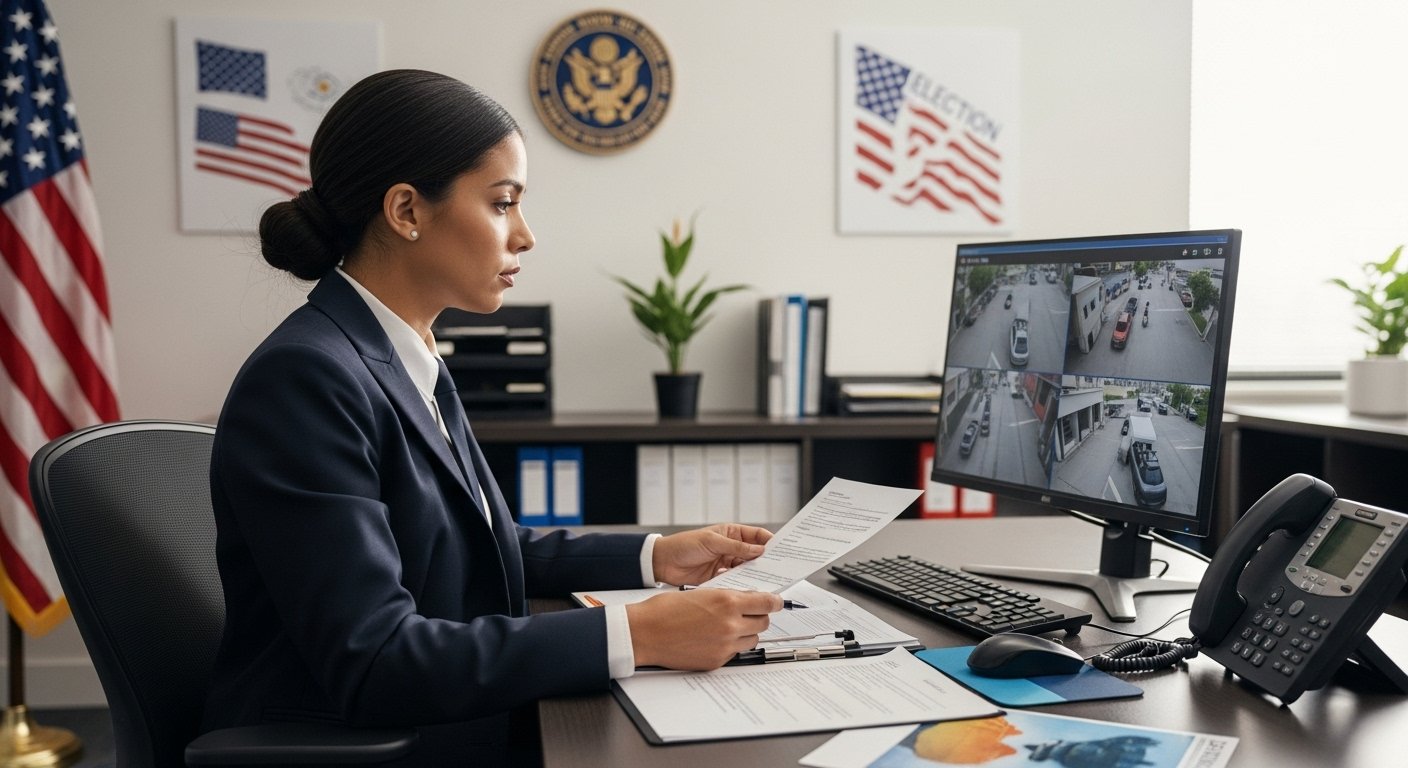State and local agencies are turning to AI in Public Works to improve infrastructure monitoring, boost accessibility, and strengthen community engagement. As expectations rise for efficiency, transparency, and equitable service delivery, many departments are leveraging AI-powered video solutions to modernize operations and foster public trust.
From bridge inspections and streetlight maintenance to community forums and transportation planning, Public Works teams manage vast responsibilities that directly impact urban safety and quality of life. Traditionally reactive and resource-intensive, these workflows are now evolving into data-driven, proactive systems through the adoption of tools like video analytics, automated transcription, and sentiment analysis.
In this blog, we explore how AI is transforming infrastructure management, helping agencies meet compliance mandates, and enabling more inclusive digital communication. These advancements are driving smarter and safer communities across the country.
Challenges in Public Works Operations
Public Works departments are under growing pressure to deliver more efficient, transparent, and inclusive services. Yet, several long-standing challenges continue to hinder progress.

Below are the key barriers agencies face, all of which are addressed through AI-powered solutions in this blog.
Inequitable Access to Public Communication
Language barriers, hearing disabilities, and poor digital accessibility prevent many residents from receiving critical updates about infrastructure projects, closures, or safety advisories.
This leads to reduced civic participation and can erode public trust.
Manual Feedback Analysis Limits Responsiveness
Agencies often collect valuable public input through meetings and forums, but struggle to analyze it efficiently.
Reviewing hours of unstructured video and audio feedback is time-consuming and may result in missed priorities or overlooked concerns.
Resource-Intensive and Risk-Prone Inspections
Traditional bridge and infrastructure inspections rely heavily on manual labor and on-site evaluations.
These methods are costly, slow, and carry a higher risk of human error, potentially delaying maintenance and endangering public safety.
Lack of Real-Time Data for Mobility Planning
Cities investing in bike lanes, crosswalks, and pedestrian zones often lack the continuous usage data needed to plan effectively.
Without accurate insights, safety improvements and infrastructure investments may be misaligned with actual community needs.
Reactive Maintenance and Delayed Issue Detection
Many agencies rely on public reports or routine patrols to identify infrastructure problems, resulting in prolonged service disruptions or preventable hazards.
A lack of real-time monitoring limits the ability to act proactively.
Time-Consuming Signage Management
Maintaining a large inventory of traffic and public safety signs requires checking for reflectivity, visibility, placement, and damage.
When done manually, this is both labor-intensive and difficult to scale.
Disorganized Video Content Archives
Public Works teams produce large volumes of video from inspections, meetings, and communications.
Without intelligent organization, finding specific footage becomes frustrating and inefficient, hindering collaboration and transparency.
Use Cases of AI in Public Works
The benefits of artificial intelligence in Public Works extend far beyond automation. From improving public communication to enhancing infrastructure safety and streamlining operations, AI is helping state and local agencies address long-standing challenges with greater speed, accuracy, and transparency.

The following use cases illustrate how different Public Works functions are being transformed through AI-powered solutions.
Ensuring Accessible Communication for All Residents
Public Works departments often rely on community feedback to prioritize projects, allocate resources, and address emerging concerns. Whether it's through public forums, infrastructure hearings, or online comment sessions, this input holds valuable insights. However, manually reviewing hours of video or unstructured audio feedback is time-consuming and often leads to missed patterns or sentiments.
That’s where AI in Public Works offers a meaningful solution. With VIDIZMO’s AI-powered transcription and translation capabilities, agencies can automatically generate multilingual captions and transcripts for video content such as public service announcements, construction briefings, and town hall recordings. This ensures that residents who are hard of hearing or have limited English proficiency can still fully access and understand critical updates.
In addition to improving civic engagement, these tools also help agencies comply with ADA and Section 508 accessibility mandates, reducing legal risk and demonstrating a commitment to equitable public service. By making digital communication inclusive by default, Public Works departments can foster broader participation, build trust, and uphold the transparency that today’s communities expect. This reflects real AI utilization in public works and the broader scope of AI in public administration.
Turning Public Feedback Into Actionable Insights
Public Works departments often rely on community feedback to prioritize projects, allocate resources, and address emerging concerns. Whether it's through public forums, infrastructure hearings, or online comment sessions, this input holds valuable insights. However, manually reviewing hours of video or unstructured audio feedback is time-consuming and often leads to missed patterns or sentiments.
AI in Public Works simplifies this process by turning raw public commentary into structured, actionable data. With VIDIZMO’s Public Engagement Analysis Solution, agencies can process video and audio recordings from town halls, feedback sessions, or community meetings to extract sentiment, detect recurring topics, and identify urgent concerns.
For example, if multiple residents express concerns about pedestrian safety in a particular neighbourhood, AI-powered sentiment analysis can flag the issue for further review, enabling the department to respond proactively. These insights help Public Works teams make data-driven decisions, enhance service responsiveness, and demonstrate a genuine commitment to public input.
By harnessing AI utilization in public works to systematically analyze community feedback, agencies can optimize project planning, improve resource utilization, and support more accountable AI in public administration.
Smarter, Safer Bridge Inspections with Video Analytics
Bridges are vital to a state's transportation infrastructure, yet manual inspections remain labor-intensive, costly, and prone to human error. These traditional methods make it challenging to monitor structural integrity at scale and often result in delayed maintenance or overlooked deterioration.
AI in Public Works offers a safer, more scalable alternative. By integrating AI-powered video analytics with drone footage, Public Works departments can automate inspections to detect early signs of damage, such as cracks, corrosion, or surface irregularities. These systems use computer vision to scan hours of video data and flag anomalies with high precision.
Beyond detection, machine learning models can analyze historical footage and inspection data to predict future deterioration. This proactive approach enables teams to schedule timely maintenance, reduce the risk of structural failure, and optimize repair budgets.
By driving AI utilization in public works, bridge inspections not only improve safety outcomes but also free up personnel to focus on higher-value tasks. This reflects a forward-thinking application of AI in public administration that supports safer infrastructure and better resource planning.
Automated Pedestrian and Bicycle Traffic Analysis
As cities and towns invest in active transportation infrastructure, such as bike lanes, crosswalks, and pedestrian-friendly streets, accurate usage data is essential for effective planning. However, manually counting foot and bike traffic is resource-intensive and rarely provides a complete picture.
AI in Public Works brings automation and accuracy to the forefront. With VIDIZMO’s customizable Video Analytics and Detection capabilities, Public Works departments can use CCTV or roadside cameras to automatically detect, count, and analyze pedestrian and bicycle activity. This includes tracking usage patterns by time of day, location, and volume trends over time.
These insights help agencies understand where investments in safety improvements, lighting, signage, or infrastructure expansion are most needed. For example, identifying high-traffic pedestrian areas with poor visibility can inform crosswalk upgrades or traffic calming measures.
According to the Federal Highway Administration, pedestrians and bicyclists accounted for 20% of U.S. traffic fatalities in 2024, including approximately 7,000 pedestrian and 1,000 bicyclist deaths. AI-powered traffic analysis tools can help Public Works agencies identify risk zones, plan safer infrastructure, and reduce these preventable incidents.
By leveraging AI utilization in public works for this type of data collection, departments reduce the need for costly manual surveys and gain the real-time intelligence required for data-driven planning and budgeting. These efforts represent a meaningful application of AI in public administration to improve urban mobility and public safety.
Real-Time Infrastructure Monitoring and Maintenance
Public Works departments are tasked with maintaining a wide range of public assets: roads, lighting, signage, parks, and other community infrastructure. Traditional inspection methods often depend on manual patrols or delayed reporting, which can result in prolonged outages, unaddressed hazards, or unnoticed damage.
With AI in Public Works, departments can adopt a proactive, real-time approach to infrastructure monitoring. VIDIZMO’s Video Analytics and Detection Solution can analyze live CCTV or drone footage to automatically detect issues such as:
- Streetlight outages
- Road surface damage
- Illegal dumping or vandalism
- Blocked signage or structural anomalies
Once detected, the system generates instant alerts, enabling field teams to respond quickly and efficiently. This approach reduces service downtime, enhances public safety, and preserves the overall appearance and functionality of community spaces.
By shifting from reactive to predictive maintenance, agencies not only improve response times but also support more strategic AI utilization in public works. These proactive workflows reflect the evolving role of AI in public administration, where smart technology drives efficiency, accountability, and better service delivery.
Enhancing Public Sign Inventory and Compliance
From traffic control to wayfinding and safety alerts, public signage plays a critical role in keeping roadways and communities safe. However, maintaining a large inventory of signs, each with its own regulations for placement, reflectivity, and condition, is a time-consuming and error-prone process when done manually.
With AI for Public Works, these tasks can be automated and streamlined. VIDIZMO’s Video Analytics and Detection Solution uses computer vision and machine learning to identify, catalogue, and assess signage from video or image data captured via mobile units or drones. The system evaluates key compliance factors such as:
- Reflectivity and visibility under different lighting conditions
- Height, spacing, and orientation regulations
- Physical condition, obstructions, or wear and tear
The platform then generates actionable reports that help prioritize maintenance, ensure safety compliance, and improve roadway visibility. This not only supports public safety but also reduces administrative burden and ensures that signage infrastructure remains in line with state and federal standards.
By automating sign inventory management, Public Works departments demonstrate practical AI utilization in public works, while also contributing to the broader modernization goals of AI in public administration.
Streamlining Video Content Management with EnterpriseTube
Public Works departments generate and store massive amounts of video content, including infrastructure inspections, construction updates, public service announcements, and meeting recordings. However, without an organized system in place, locating specific footage when it’s needed can be slow, frustrating, and inefficient.
That’s where VIDIZMO EnterpriseTube, an AI-powered video content management system (VCMS), proves invaluable.
Built for government agencies, EnterpriseTube uses Natural Language Processing (NLP) and topic modelling to automatically tag and organize video files by key themes, locations, speakers, and visual elements, as demonstrated in our case study with the U.S. Department of State, which centralized and secured sensitive video content at scale.
This makes it easier for Public Works staff to:
- Instantly search and retrieve relevant footage
- Share videos with stakeholders, contractors, or the public
- Maintain compliance with records management policies
- Eliminate duplication and reduce time spent on manual cataloguing
Whether you're reviewing archived bridge inspection footage or compiling clips for a public-facing infrastructure report, EnterpriseTube ensures that your video assets are searchable, secure, and easily accessible.
By centralizing video management, Public Works departments improve operational workflows, enhance collaboration, and support transparency, all while maximizing the value of their digital media archives.
Why AI for Public Works Is a Smart Investment
As demands for transparency, efficiency, and accessibility grow, AI for Public Works offers a practical path to modernize infrastructure management and service delivery. From automating bridge inspections to analyzing public feedback, AI-powered video solutions help departments operate more effectively and serve communities more inclusively.
With tools like video analytics, multilingual transcription, and intelligent video content management, Public Works agencies can reduce manual workloads, improve public engagement, and stay compliant with safety and accessibility standards. These innovations are not just enhancing daily operations, they're shaping smarter, safer cities.
Curious how your department can benefit from AI in public sector infrastructure? Explore our AI services.
People Also Ask
What is AI for Public Works, and how is it used?
AI for Public Works refers to the use of artificial intelligence technologies, such as video analytics, transcription, and machine learning, to improve infrastructure management, maintenance, and citizen engagement. It automates tasks like inspections, traffic analysis, and data processing.
How can Public Works departments use AI for bridge inspections?
Public Works departments can use AI-powered video analytics to analyze drone footage and detect structural issues like cracks or corrosion. Machine learning models can also predict future deterioration to help prioritize preventive maintenance, supporting smarter transportation infrastructure planning.
What are the benefits of video analytics in Public Works?
Video analytics helps Public Works teams monitor infrastructure in real-time, detect issues like vandalism or equipment failure, and automate inspections. It improves safety, efficiency, and response times.
How does AI help with citizen engagement in Public Works?
AI tools analyze video and audio feedback from community meetings to identify concerns, sentiment trends, and public priorities. This enables more responsive planning and fosters transparency.
Can AI help Public Works departments meet accessibility requirements?
Yes, AI-powered transcription and translation tools automatically generate captions and multilingual content for video updates, helping agencies comply with ADA and Section 508 regulations.
What role does AI play in pedestrian and bicycle traffic analysis?
AI systems use computer vision to count and analyze pedestrian and bicycle traffic patterns. This helps Public Works departments make informed decisions about infrastructure investments and safety improvements.
How can AI streamline public sign inventory management?
AI uses video and image data to identify, catalogue, and assess public signs based on reflectivity, placement, and condition. This automates compliance checks and reduces manual inspection workloads.
What is the role of video content management in Public Works?
A video content management system helps organize and retrieve infrastructure footage, inspection videos, and public briefings. It ensures fast access, secure storage, and better workflow efficiency.
Is AI for Public Works expensive to implement?
AI for Public Works can be implemented cost-effectively, especially when integrated with existing infrastructure like CCTV systems. Solutions are scalable based on agency needs.
How can Public Works departments get started with AI solutions?
Departments can begin by identifying use cases such as video analysis or multilingual communication. Working with a trusted provider like VIDIZMO helps tailor AI services to specific operational goals.






No Comments Yet
Let us know what you think